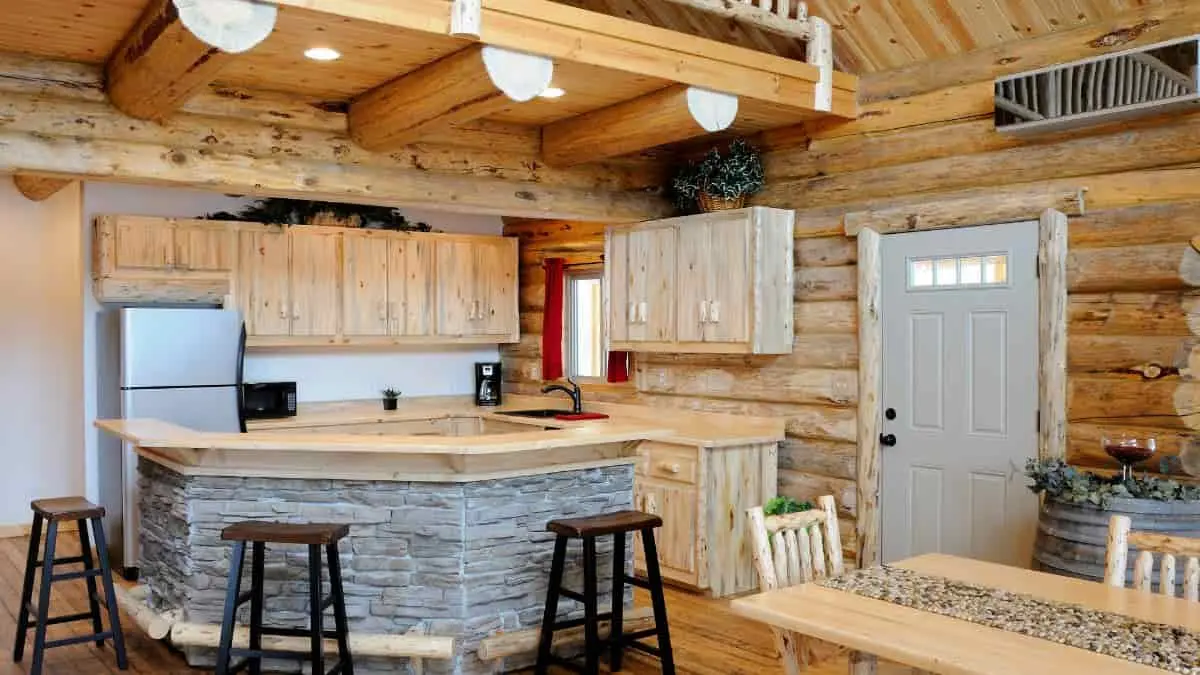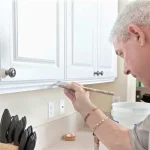A rustic kitchen creates a warm, inviting atmosphere that blends natural materials with vintage charm. This design style focuses on simplicity, comfort, and a connection to nature. Rustic kitchens typically feature elements such as reclaimed wood, stone, and earthy color palettes, giving the space an authentic, timeless appeal. Incorporating rustic elements can be a perfect solution if you’re looking to transform your kitchen into a cozy retreat.
The beauty of a rustic kitchen lies in its versatility—you don’t need a full remodel to achieve this look. Small changes, like adding open shelving, using natural materials, or installing vintage-inspired fixtures, can quickly bring rustic charm into your home.
In this guide, we’ll explore 10 practical ideas to help you create a charming rustic kitchen that’s both functional and stylish. Whether you’re planning a major renovation or looking for simple updates, these ideas will give you actionable inspiration to get started.
1. Use Reclaimed Wood for That Authentic Rustic Vibe
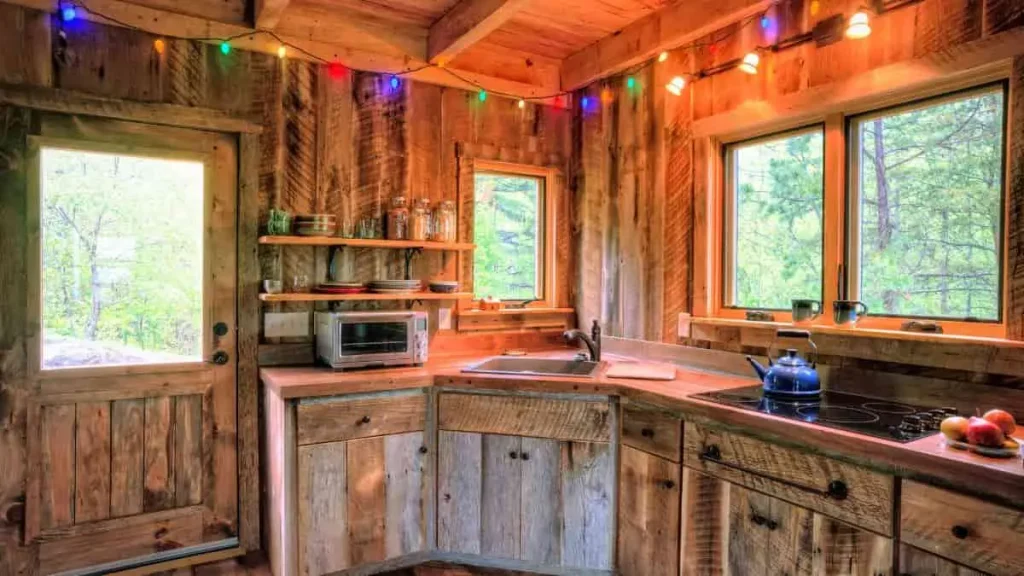
Using reclaimed wood is one of the most effective ways to give your kitchen an authentic rustic feel. Reclaimed wood refers to previously used timber repurposed for new projects. This material often comes from old barns, warehouses, or other structures, providing both a sustainable and aesthetically rich option for homeowners. Reclaimed wood’s distinct texture and weathered appearance instantly add warmth and character to any kitchen space.
You can integrate reclaimed wood in multiple ways to achieve the rustic look. For example, consider using it for your kitchen cabinets. Reclaimed wood cabinets are not only durable but also give your kitchen a unique, one-of-a-kind appearance. The imperfections and natural aging of the wood add a sense of history and charm to your kitchen, which is central to the rustic aesthetic.
Another option is to install reclaimed wood countertops. The natural grain and tones of the wood can create a beautiful contrast against modern appliances, balancing both rustic and contemporary styles. Additionally, reclaimed wood can be used for open shelving or as a focal point, such as a wooden kitchen island. By focusing on just one area—like an island or a feature wall—you can introduce rustic elements without overwhelming the entire kitchen design.
Beyond aesthetics, using reclaimed wood is an eco-friendly choice. It reduces the demand for new timber and helps to recycle materials that would otherwise go to waste. To source reclaimed wood, you can explore local salvage yards, dedicated suppliers, or even repurpose old furniture or pallets yourself. This flexibility in sourcing makes reclaimed wood both an affordable and practical option for many homeowners.
2. Opt for Open Shelving to Show Off Rustic Charm
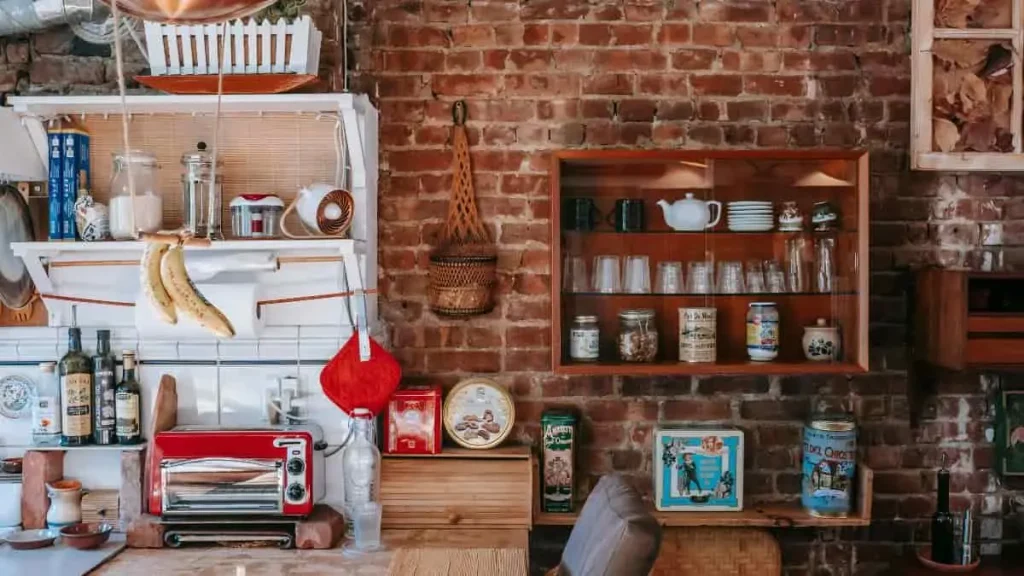
Open shelving is another popular feature in rustic kitchens, offering both practicality and aesthetic appeal. Unlike closed cabinets, open shelves allow you to display kitchen essentials in a way that feels more natural and lived-in. This style fits seamlessly with the rustic design philosophy, which favors simplicity and functionality over formal, polished finishes.
The charm of open shelving lies in its ability to showcase your rustic kitchenware, such as wooden bowls, ceramic dishes, or vintage copper pots. Instead of hiding your kitchen items behind closed doors, open shelving encourages you to embrace a more organic, approachable look. Wooden shelves, particularly those made from reclaimed wood or rough-hewn timber, enhance the rustic feel even further.
To balance practicality with aesthetics, consider using open shelving in combination with closed cabinetry. This way, you can display your most attractive items while keeping everyday clutter out of sight. For example, open shelves near the stove can hold frequently used items like spices, pots, or cutting boards, while closed cabinets can store larger or less visually appealing items. This balance ensures that your kitchen remains functional without sacrificing the rustic charm you’re aiming for.
When installing open shelving, it’s important to pay attention to the hardware as well. Iron or brass brackets can add to the rustic feel, especially when paired with natural wood shelves. These materials complement the overall rustic theme, while the openness of the shelves prevents the kitchen from feeling too closed-off or heavy. By strategically placing open shelving in key areas, you can create a more airy, inviting space that highlights the best features of your rustic kitchen design.
3. Vintage-Inspired Fixtures for a Nostalgic Touch
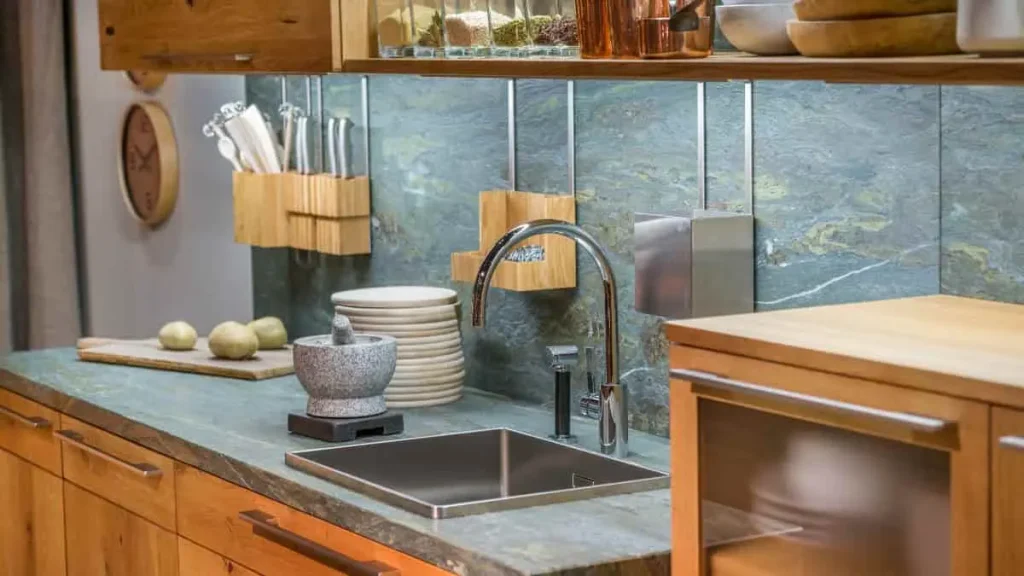
Incorporating vintage-inspired fixtures is a simple yet impactful way to bring a nostalgic touch to your rustic kitchen. These fixtures, such as faucets, sinks, and lighting, play a crucial role in establishing the overall style of the space. Vintage designs often include intricate details, soft curves, and durable materials like copper or brass, which enhance the warmth and timelessness of a rustic kitchen.
One of the most defining elements of a rustic kitchen is the farmhouse sink. Also known as an apron-front sink, this fixture blends functionality with style. Its deep basin is perfect for handling large pots and pans, while the exposed front adds a vintage flair. Typically made from materials such as porcelain or cast iron, farmhouse sinks evoke a sense of durability and simplicity, both of which are essential to the rustic aesthetic.
Another fixture that adds charm to your kitchen is a vintage-style faucet. Opt for designs with curved spouts and cross handles, which are reminiscent of early 20th-century kitchens. Brass or oil-rubbed bronze finishes pair beautifully with rustic cabinetry and countertops, enhancing the overall old-world feel of the space. These materials develop a natural patina over time, further adding to the kitchen’s lived-in, nostalgic look.
Lighting fixtures are equally important in capturing the rustic essence. Consider pendant lights with metal or glass shades, or even lantern-style lighting for a truly vintage feel. These types of fixtures not only illuminate the space but also serve as decorative elements that anchor the rustic design. Vintage-inspired lighting often features materials like iron or aged metals, which complement natural wood and stone elements found in rustic kitchens. By carefully choosing these vintage fixtures, you can create a cohesive look that blends nostalgia with the practicality needed in a modern kitchen.
4. Exposed Beams for a Timeless Look
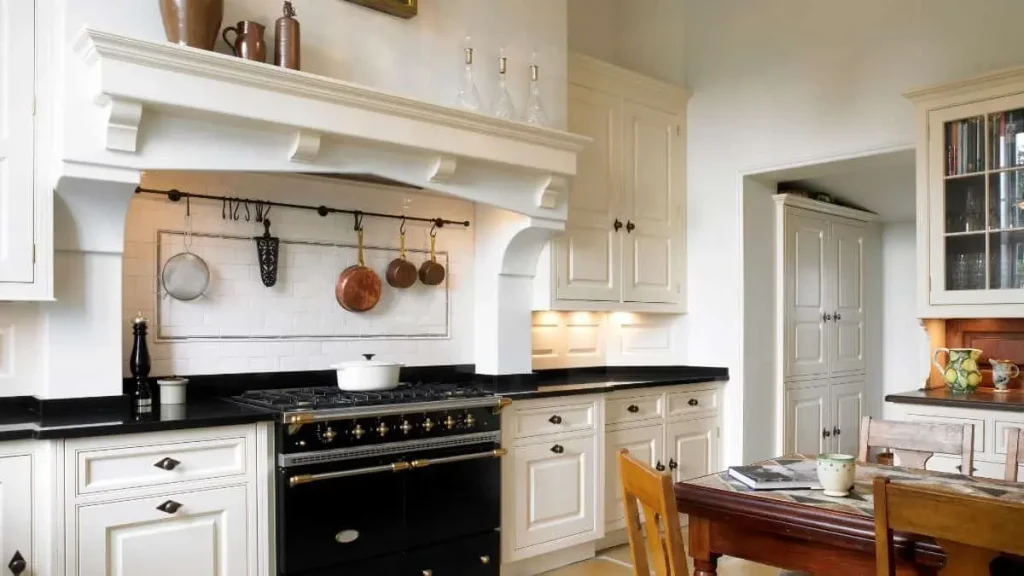
Exposed wooden beams are a hallmark of rustic kitchen design, offering a structural element that brings both visual interest and warmth to the space. These beams, often left in their natural, unpolished state, serve as a reminder of the kitchen’s connection to traditional craftsmanship and simpler times. Whether your home already has exposed beams or you’re considering adding faux beams, they can transform the look and feel of your kitchen.
The beauty of exposed beams lies in their ability to create an open, expansive atmosphere while adding texture and depth to the ceiling. They provide a strong contrast to modern kitchens, which tend to emphasize sleek, flat surfaces. Wooden beams bring in natural, raw elements that are at the core of rustic design, and their rough, unfinished surfaces add an organic touch to the kitchen. Using reclaimed wood beams amplifies this effect, giving the space an even more authentic rustic appeal, as the natural imperfections in the wood add character and uniqueness.
Even in smaller kitchens, faux beams can be used effectively to achieve the same rustic vibe without the need for structural changes. Faux beams made from lightweight materials can mimic the look of solid wood and are often easier to install, making them a practical option for homeowners who want the aesthetic benefits of exposed beams without a major renovation.
The combination of exposed beams with other rustic elements, such as natural stone or wood cabinetry, can create a cohesive design that feels timeless. To enhance the rustic charm, consider keeping the beams in their natural wood tones, which will harmonize with the earthy color palette typically found in rustic kitchens. Whether you choose reclaimed beams or faux options, exposed beams can instantly evoke a sense of history and craftsmanship, making your kitchen feel warm and inviting.
5. Rustic Color Palette for Cozy Vibes
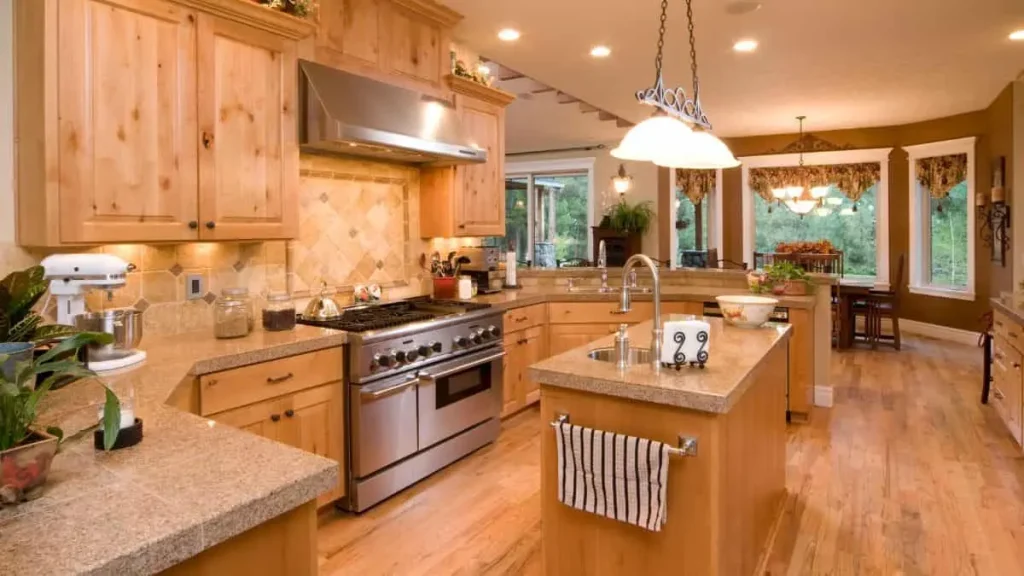
The color palette you choose for a rustic kitchen plays a crucial role in setting the right atmosphere. A rustic kitchen is all about warmth, comfort, and a connection to nature. This is why earthy, natural tones are often the foundation of the design. These colors not only complement natural materials like wood and stone but also create a sense of coziness and relaxation.
To achieve a rustic color palette, it’s important to use soft, muted shades that evoke a natural environment. Warm beiges and creams create a calming backdrop that enhances the beauty of other rustic elements like wooden beams or stone accents. These neutral tones help keep the kitchen feeling light and open, especially when paired with darker wood tones.
In addition to neutrals, earthy shades like sage green or deep browns are perfect for adding depth and warmth to the space. These colors reflect the outdoor landscapes that inspire rustic design. For instance, a soft green can be used on cabinetry or walls to complement natural wood finishes, while deep browns in countertops or flooring add richness to the overall design. You can also incorporate touches of warm white to balance out the darker hues and maintain a fresh, airy feel.
A two-tone approach can also work well in a rustic kitchen. Combining natural wood cabinets with a painted island in a complementary earthy tone adds visual interest without overwhelming the space. This approach allows you to maintain the rustic charm while introducing subtle variations in color that make the design more dynamic. Overall, the right color palette enhances the natural beauty of your rustic kitchen while creating a cozy, welcoming environment.
Recommended: Best Kitchen Color Schemes
6. Mix in Antique or Repurposed Furniture
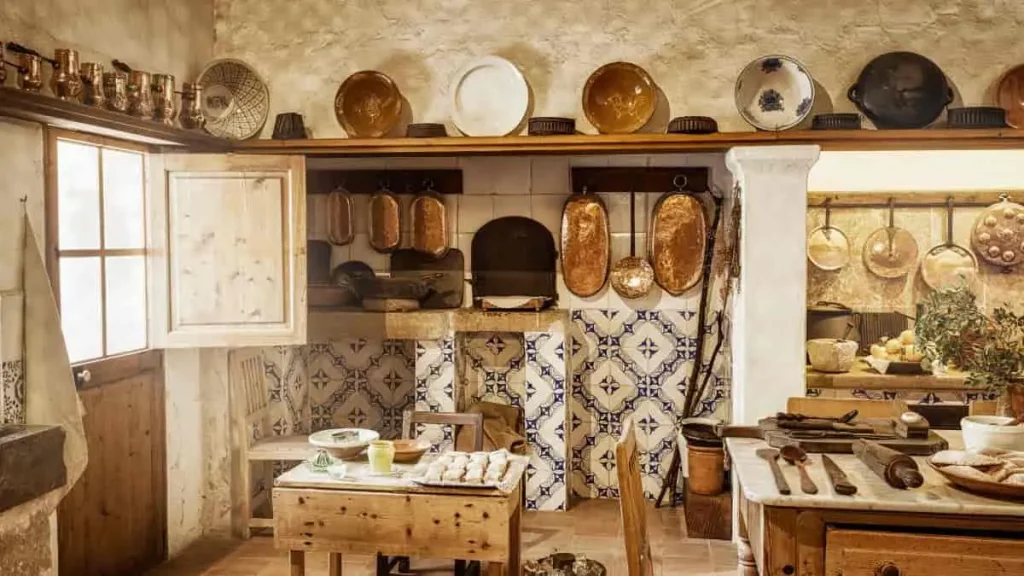
Antique or repurposed furniture is an excellent way to bring a personalized, rustic touch to your kitchen. These pieces add a sense of history and uniqueness, which aligns perfectly with the rustic style. In many cases, antique furniture showcases craftsmanship and materials that are difficult to find in modern pieces, making them a valuable addition to any rustic kitchen.
One way to incorporate antique furniture is by repurposing a vintage hutch or sideboard for kitchen storage. These pieces, often made of solid wood, add both functionality and rustic charm. With their aged patina and sturdy construction, antique furniture can serve as a focal point, whether used for storing dishes or displaying rustic kitchenware. The natural imperfections in older furniture, such as distressed wood or worn edges, only enhance the rustic aesthetic, making the kitchen feel lived-in and authentic.
Incorporating a repurposed dining table or kitchen island is another way to merge style with practicality. A weathered farmhouse table, for instance, brings an inviting, communal feel to the kitchen, encouraging family gatherings and a sense of warmth. You can also transform other antique pieces—such as using an old workbench as a kitchen island—into functional elements that maintain the rustic appeal. These repurposed pieces not only reduce waste but also provide a budget-friendly option for homeowners looking to enhance their kitchens without a full remodel.
When adding antique or repurposed furniture, it’s important to balance the old with the new. Pairing vintage pieces with modern appliances ensures that your kitchen remains functional while still embracing the rustic charm. The contrast between modern stainless steel and antique wood creates an interesting design tension, allowing both elements to stand out without overpowering one another. By mixing antique or repurposed furniture into your kitchen, you can create a space that feels personal, timeless, and full of character.
7. Stone or Brick for a Rustic, Textured Look
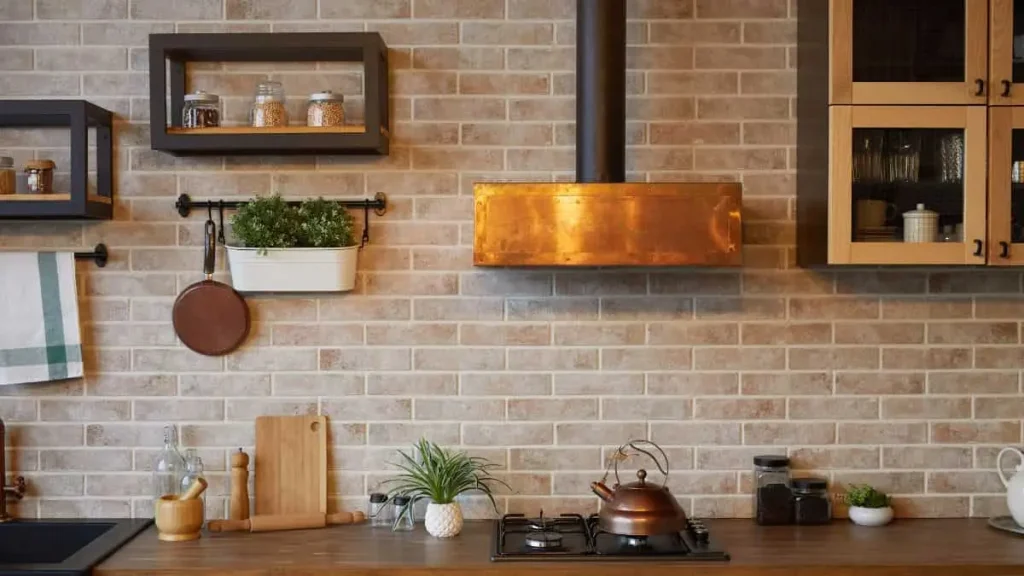
Incorporating stone or brick into your kitchen design is an excellent way to achieve a rustic, textured look. Both materials have long been associated with traditional, rural homes and instantly add depth and character to the space. The natural, uneven surfaces of stone and brick create a tactile quality that makes the kitchen feel more grounded and connected to nature.
Stone can be used in various parts of the kitchen to bring out a rustic charm. A stone backsplash behind the stove or sink can serve as a focal point, contrasting beautifully with smooth countertops or wooden cabinets. The variation in the stone’s natural colors and textures brings in warmth, especially when paired with earthy tones or rustic wood. Another option is using stone veneer on a kitchen island, providing a rustic touch that feels substantial without the weight or expense of solid stone. This technique maintains the rugged look that rustic kitchens are known for while allowing more flexibility in design.
Brick is another popular choice for adding a textured element to a rustic kitchen. A brick accent wall creates an industrial yet cozy vibe, especially when left in its natural red or earthy tones. For homeowners who want a slightly softer look, painting the brick in white or a light gray can maintain the texture while adding a more subtle, rustic feel. Brick flooring is another option, offering both durability and an unmistakable rustic appearance that complements the overall design of the kitchen. The uneven surface of brick creates a sense of history, making the kitchen feel timeless and lived-in.
Both stone and brick are known for their durability, making them practical choices for high-traffic areas like kitchens. These materials also retain heat well, which can add to the cozy ambiance in a rustic kitchen. Whether you choose to use them on walls, floors, or as accents, stone and brick instantly elevate the rustic appeal of your kitchen by adding texture, warmth, and an authentic sense of history.
8. Rustic Lighting Options to Set the Mood
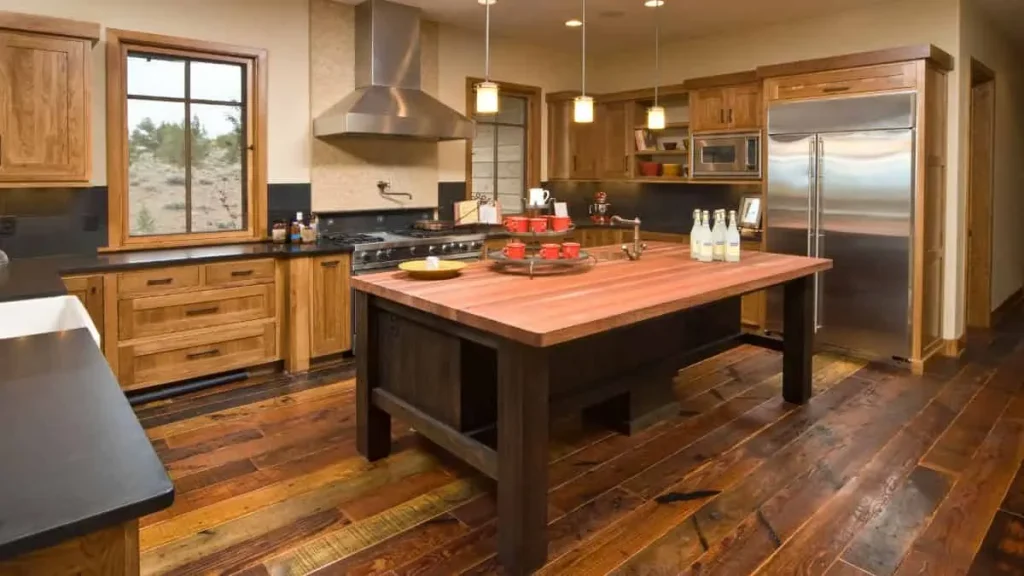
Lighting plays a critical role in shaping the overall atmosphere of your rustic kitchen. While functional, lighting in a rustic kitchen should also enhance the warmth and coziness of the space. Rustic lighting options often focus on natural materials, simple designs, and a warm color temperature that complements the earthy tones and textures commonly found in rustic kitchens.
One of the most popular choices for rustic kitchen lighting is pendant lights with metal or glass shades. These lights, often suspended over kitchen islands or dining areas, bring a farmhouse-inspired feel to the space. Aged metals like iron, copper, or brass are frequently used in rustic lighting fixtures, as they develop a natural patina over time that enhances the lived-in look of the kitchen. Industrial-style pendant lights with exposed bulbs also add a raw, vintage charm, especially when paired with wooden beams or stone accents.
Another option is chandeliers with rustic detailing, such as wood or wrought iron elements. These chandeliers often have a handcrafted look, with simple lines and minimal ornamentation, making them perfect for a rustic kitchen. Placing a chandelier above a farmhouse dining table or in the center of the kitchen can create a focal point that draws attention to the rustic features of the room. Candle-style lights within the chandelier can mimic the soft, warm glow of natural light, adding to the kitchen’s cozy atmosphere.
For task lighting, under-cabinet lights with a warm, soft glow are ideal for maintaining a rustic feel while ensuring practicality. The goal with rustic lighting is to avoid harsh, cool-toned lights, which can make the space feel more sterile and modern. Instead, opt for warm lighting options that create an inviting environment.
When choosing rustic lighting fixtures, it’s essential to consider how they work with other elements in the kitchen, such as exposed beams, stone or brick walls, and wooden cabinetry. The right lighting can highlight these features while setting the tone for a relaxed, welcoming kitchen space.
9. Incorporate Nature with Plants & Natural Textiles
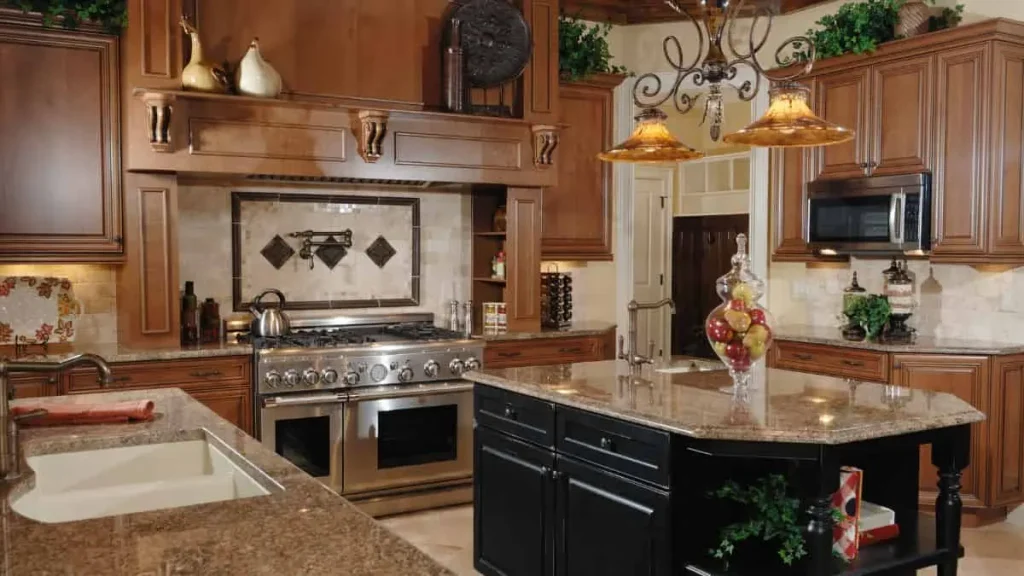
Bringing elements of nature into your rustic kitchen is essential for enhancing the warm, organic feel of the space. Plants and natural textiles are simple yet powerful ways to create a connection with the outdoors, reinforcing the rustic theme. These elements introduce life, color, and texture to your kitchen, making it feel more inviting and rooted in nature.
Plants are a perfect addition to any rustic kitchen. Herbs like basil, rosemary, or thyme can be placed in small pots on the windowsill or hung in baskets to provide both greenery and a practical use in cooking. These potted herbs not only add a burst of fresh, vibrant color but also infuse the kitchen with pleasant aromas that complement the rustic ambiance. Larger plants, such as ferns or potted trees, can also be positioned in corners or near windows to soften the edges of the room and make the space feel more natural and relaxed.
For homeowners who prefer a more subtle touch, dried flowers or eucalyptus can be used in vases as low-maintenance alternatives. These additions offer the beauty of nature without requiring constant care, and their muted tones blend seamlessly with the rustic color palette.
Natural textiles further emphasize the rustic look and feel of your kitchen. Materials such as linen, cotton, burlap, and wool introduce texture and warmth, enhancing the sense of comfort. Linen or cotton curtains in neutral or earthy tones allow natural light to flow in while maintaining a soft, rustic aesthetic. Burlap or jute table runners, along with woven or woolen area rugs, can add a cozy layer of texture to the dining area or underfoot in high-traffic spaces.
Using natural textiles for kitchen towels, oven mitts, or chair cushions ties these small yet impactful details together. The key is to focus on materials that look and feel organic, adding softness without clashing with the other rougher elements in your rustic kitchen, such as wood and stone. By integrating plants and natural textiles, you create a kitchen that feels harmonious with the natural world, a key feature of any rustic design.
Related: Eco-Friendly Kitchen Remodel
10. Add Finishing Touches with Rustic Accessories
The finishing touches are what truly personalize a rustic kitchen and tie the entire design together. Rustic accessories add character and charm, completing the look in a way that feels intentional yet effortless. These items, often inspired by rural life or handcrafted details, bring the warmth and authenticity that define rustic design.
Start by incorporating vintage kitchen tools or decor, such as wooden cutting boards, copper pots, or ceramic bowls, which can be displayed on open shelves or hung from racks. These practical accessories double as decorative elements, showcasing the simplicity and functionality that is core to rustic kitchens. Cast-iron skillets, antique measuring cups, and even enamelware add to the nostalgic appeal, reinforcing the timeless nature of the space.
Handmade items are another great way to bring authenticity into your kitchen. Think of pottery, handwoven baskets, or hand-carved wooden utensils, which introduce a personal, artisanal touch. These items not only fit the rustic aesthetic but also support the idea of craftsmanship, an important aspect of rustic design. For example, displaying woven baskets filled with fresh produce or storing bread in an old-fashioned ceramic bread box adds layers of rustic charm while maintaining functionality.
In addition to functional accessories, consider adding rustic decorative items like weathered picture frames, vintage clocks, or old signage. These elements bring a sense of history and nostalgia to your kitchen. Antique or handmade textiles, like embroidered dishcloths or crocheted pot holders, can be casually draped over surfaces for an added layer of rustic detail.
Lighting accessories such as lanterns or candleholders, particularly in metal or wood, can also serve as decorative yet functional elements. The flicker of candlelight or the soft glow from a lantern enhances the cozy atmosphere, making the kitchen feel like a welcoming retreat. By layering in these thoughtful, rustic accessories, you bring a sense of completion to your kitchen design, creating a space that is not only beautiful but deeply personal and full of charm.
Conclusion
Achieving a charming rustic kitchen involves more than just selecting the right materials and finishes; it’s about creating a space that feels warm, welcoming, and authentically connected to nature. By focusing on key elements like reclaimed wood, vintage-inspired fixtures, and natural textures, you can design a kitchen that radiates timeless charm. Adding features such as open shelving, exposed beams, and a rustic color palette enhances the organic beauty and functionality of the space.
The beauty of a rustic kitchen lies in its flexibility. Whether you’re incorporating antique furniture, repurposing old materials, or choosing stone and brick for added texture, each element contributes to the overall feel of comfort and tradition. Thoughtful details like rustic lighting, plants, and natural textiles further elevate the atmosphere, while carefully chosen accessories tie the look together with personality and charm.
Ultimately, creating a rustic kitchen is about blending practicality with aesthetic appeal. By using these ideas and personalizing them to suit your taste and lifestyle, you can transform your kitchen into a cozy, inviting space that reflects the simplicity and beauty of rustic design.

